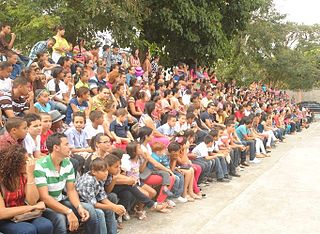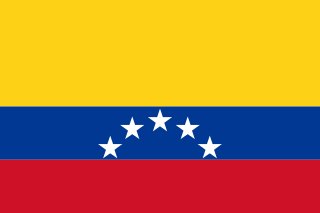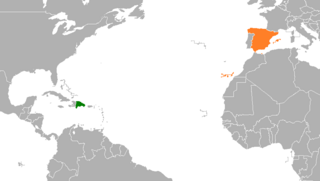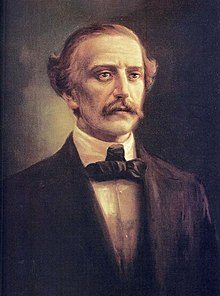
The Dominican Republic is a North American country located on the island of Hispaniola in the Greater Antilles archipelago of the Caribbean Sea, bordered by the Atlantic Ocean to the north. It occupies the eastern five-eighths of the island, which it shares with Haiti, making Hispaniola one of only two Caribbean islands, along with Saint Martin, that is shared by two sovereign states. It is the second-largest nation in the Antilles by area at 48,671 square kilometers (18,792 sq mi), and second-largest by population, with approximately 11.4 million people in 2024, of whom approximately 3.6 million live in the metropolitan area of Santo Domingo, the capital city.

The recorded history of the Dominican Republic began in 1492 when Christopher Columbus, working for the Crown of Castile, arrived at a large island in the western Atlantic Ocean, later known as the Caribbean. The native Taíno people, an Arawakan people, had inhabited the island during the pre-Columbian era, dividing it into five chiefdoms. They referred to the eastern part of the island as Quisqueya, meaning 'mother of all lands.' Columbus claimed the island for Castile, naming it La Isla Española, which was later Latinized to Hispaniola.

Hispaniola is an island between Cuba and Puerto Rico in the Greater Antilles of the Caribbean. Hispaniola is the most populous island in the West Indies, and the second-largest by land area, after Cuba. The 76,192-square-kilometre (29,418 sq mi) island is divided into two separate sovereign countries: the Spanish-speaking Dominican Republic (48,445 km2 to the east and the French and Haitian Creole–speaking Haiti (27,750 km2 to the west. The only other divided island in the Caribbean is Saint Martin, which is shared between France and the Netherlands.

Puerto Ricans, most commonly known as Boricuas, but also occasionally referred to as Borinqueños, Borincanos, or Puertorros, are an ethnic group native to the Caribbean archipelago and island of Puerto Rico, and a nation identified with the Commonwealth of Puerto Rico through ancestry, culture, or history. Puerto Ricans are predominately a tri-racial, Spanish-speaking, Christian society, descending in varying degrees from Indigenous Taíno natives, Southwestern European colonists, and West and Central African slaves, freedmen, and free Blacks. As citizens of a U.S. territory, Puerto Ricans have automatic birthright American citizenship, and are considerably influenced by American culture. The population of Puerto Ricans is between 9 and 10 million worldwide, with the overwhelming majority residing in Puerto Rico and mainland United States.
Mulatto is a racial classification that refers to people of mixed African and European ancestry only, beginning in the United States of America. Its use is considered to be outdated and offensive in some countries and languages, such as English with the exceptions of some Anglophone Caribbean or West Indian countries and Dutch, but it does not have the same associations in languages such as Spanish and Portuguese. Among Latin Americans in the US, for instance, the term can be a source of pride. A mulatta is a female mulatto.

Dominicans are an ethno-national people, a people of shared ancestry and culture, who have ancestral roots in the Dominican Republic.

The region known as Hispanic America and historically as Spanish America is all the Spanish-speaking countries of the Americas. In all of these countries, Spanish is the main language - sometimes sharing official status with one or more indigenous languages or English, and Latin Catholicism is the predominant religion.

The culture of the Dominican Republic is a diverse mixture of different influences from around the world. The Dominican people and their customs have origins consisting predominantly in a European cultural basis, with native Taíno and African influences.
Afro–Latin Americans or Black Latin Americans are Latin Americans of full or mainly sub-Saharan African ancestry.

The Republic of Spanish Haiti, also called the Independent State of Spanish Haiti was the independent state that succeeded the Captaincy General of Santo Domingo after independence was declared on November 30, 1821 by José Núñez de Cáceres. The republic lasted only from December 1, 1821 to February 9, 1822 when it was invaded by the Republic of Haiti.
Afro-Dominicans are Dominicans of predominant or full Black African ancestry. They are a minority in the country representing 7.8% of the Dominican Republic's population according to a census bureau survey in 2022. About 4.0% of the people surveyed claim an Afro-Caribbean immigrant background, while only 0.2% acknowledged Haitian descent. Currently there are many black illegal immigrants from Haiti, who are not included within the Afro-Dominican demographics as they are not legal citizens of the nation.

The Spanish West Indies, Spanish Caribbean or the Spanish Antilles were Spanish territories in the Caribbean. In terms of governance of the Spanish Empire, The Indies was the designation for all its overseas territories and was overseen by the Council of the Indies, founded in 1524 and based in Spain. When the Crown established the Viceroyalty of New Spain in 1535, the islands of the Caribbean came under its jurisdiction.
Anti-Haitian sentiment is prejudice or social discrimination against Haitians in the Dominican Republic.

The chiefdoms of Hispaniola were the primary political units employed by the Taíno inhabitants of Hispaniola in the early historical era. At the time of European contact in 1492, the island was divided into five chiefdoms or cacicazgos, each headed by a cacique or paramount chief. Below him were lesser caciques presiding over villages or districts and nitaínos, an elite class in Taíno society.

Dominican Republic–Haiti relations are the diplomatic relations between the nations of Dominican Republic and Haiti. Relations have long been hostile due to substantial ethnic and cultural differences, historic conflicts, territorial disputes, and sharing the island of Hispaniola, part of the Greater Antilles archipelago in the Caribbean region. The living standards in the Dominican Republic are considerably higher than those in Haiti. The economy of the Dominican Republic is ten times larger than that of Haiti. The migration of impoverished Haitians and historical differences have contributed to long-standing conflicts.

White Dominicans are Dominican people of predominant or full European descent. They are 17.8% of the Dominican Republic's population, according to a 2021 survey by the United Nations Population Fund. The majority of white Dominicans have ancestry from the first European settlers to arrive in Hispaniola in 1492 and are descendants of the Spanish and Portuguese who settled in the island during colonial times, as well as the French who settled in the 17th and 18th centuries. Many whites in the Dominican Republic also descend from Italians, Dutchmen, Germans, Hungarians, Scandinavians, Americans and other nationalities who have migrated between the 19th and 20th centuries. About 9.2% of the Dominican population claims a European immigrant background, according to the 2021 Fondo de Población de las Naciones Unidas survey.

Tourism in the Dominican Republic is an important sector of the country's economy. More than 10 million tourists visited the Dominican Republic in 2023, making it the most popular tourist destination in the Caribbean and putting it in the top 5 overall in the Americas. The industry accounts for 11.6% of the nation's GDP and is a particularly important source of revenue in coastal areas of the country. The nation's tropical climate, white sand beaches, diverse mountainous landscape and colonial history attracts visitors from around the world. In 2022, the nation's tourism was named the best-performing nation post-pandemic with over 5% visitors more in comparison to pre-pandemic levels in 2019.

Dominican Republic–Spain relations are the bilateral relations between the Dominican Republic and Spain. Both nations are members of the Association of Academies of the Spanish Language and the Organization of Ibero-American States.

Dominican art comprises all the visual arts and plastic arts made in Dominican Republic. Since ancient times, various groups have inhabited the island of Ayíti/Quisqueya, or Hispaniola ; the history of its art is generally compartmentalized in the same three periods throughout Dominican history: pre-Hispanic or aboriginal Amerindian, Hispanic or colonial, and the national or Dominican period.

The Dominican diaspora consists of Dominican people and their descendants living outside of the Dominican Republic. Countries with significant numbers of Dominicans include the United States and Spain. These two nations have had historical ties to the Dominican Republic and thus it is the primary destination for many migrants. Many Dominicans migrate to the United States via Puerto Rico in rafts.























